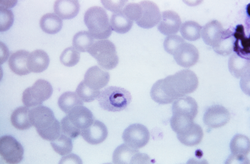Biology:Plasmodium ovale wallikeri
From HandWiki
Revision as of 23:25, 6 August 2021 by imported>AstroAI (correction)
Short description: Subspecies of single-celled organism
| Plasmodium ovale wallikeri | |
|---|---|

| |
| Plasmodium ovale trophozoite, Giemsa stain. | |
| Scientific classification | |
| Domain: | Eukaryota |
| Clade: | Diaphoretickes |
| Clade: | SAR |
| Clade: | Alveolata |
| Phylum: | Apicomplexa |
| Class: | Aconoidasida |
| Order: | Haemospororida |
| Family: | Plasmodiidae |
| Genus: | Plasmodium |
| Species: | |
| Subspecies: | P. o. wallikeri
|
| Trinomial name | |
| Plasmodium ovale wallikeri Sutherland, et al. 2010
| |
Plasmodium ovale wallikeri is a subspecies of parasitic protozoa that causes tertian malaria in humans. The subspecies was described in 2010 when it was established that the two subspecies of Plasmodium ovale, while morphologically identical are genetically distinct.[1]
Epidemiology
Plasmodium ovale wallikeri has been identified in Ghana, Myanmar, Nigeria, São Tomé, Sierra Leone and Uganda.
Clinical features
Clinical features for P. ovale wallikeri are described in the article on Plasmodium ovale.
Phylogenetics
This species separated from its closest known relative - Plasmodium ovale curtisi - between 1.0 and 3.5 million years ago.
References
- ↑ "Two nonrecombining sympatric forms of the human malaria parasite Plasmodium ovale occur globally". J Infect Dis 201 (10): 1544–50. 2010. doi:10.1086/652240. PMID 20380562.
Wikidata ☰ Q7201935 entry
 |

